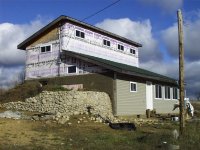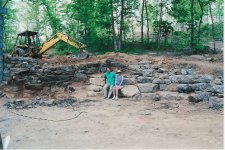Matthew,
It's also going to depend on the soil. One thing Michigan has is a lot of beach sand. I tried dry laying my retaining wall. Got it up about 6' high and it looked real nice. Then one day I was out in back picking rocks and the plumber showed up. "That's too bad about your wall", he said.
Needless to say, the sand backfill had dried out and while I was back picking rocks, it had spilled (flowed like water actually), starting at the top and working about 1/3rd of the way down the wall, taking all that work with it. Good thing I wasn't standing in front of it at the time. /w3tcompact/icons/crazy.gif That's when I decided cement might be a good idea. I don't have enough of the great big rocks to do any good and the few I have I want to use for anchoring at corners. I do have about half a million the size of basketballs. So, I have a cemented, "random rubble pattern" wall. It's really not too hard to do, kinda fun, and you don't need a gym. I keep tellin folks to quit paying those high priced gym fees and just come to my Health Spa (we don't use the term forced labor camp anymore/w3tcompact/icons/laugh.gif). Shoot, for 1/2 of what they're paying for gym fees, they can come see me and I'll let them stack and haul rocks and swing the shovel. Both strength and aerobic training at a discount price. /w3tcompact/icons/laugh.gif /w3tcompact/icons/laugh.gif




